Games to Play (and Not Play) With Your Puppy
By Michele Welton, Dog Trainer, Breed Selection Consultant, Author of 15 Dog Books
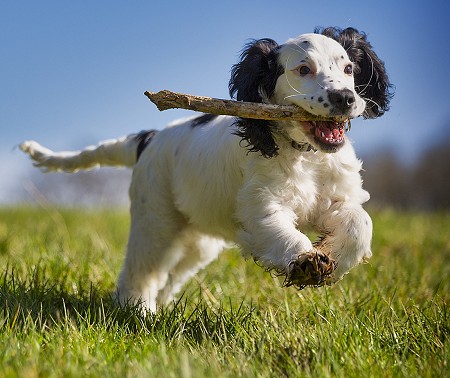
Games to Play
| ✔ | Fetch |
| ✔ | Tug |
| ✔ | Obstacle Course |
Games NOT to Play
| × | Wrestling |
| × | Chasing your pup |
Teach your dog to play fetch (retrieve)
Many dogs love chasing a ball or a thrown toy. Some will even bring the object back so you can throw it again. Retrieving (fetch) is an awesome game to play with your dog. It's an interactive and cooperative game that really improves your relationship.
Retrieving is a game. Retrieving is not an essential lesson like "Come" or "Wait" or "Quiet." We don't use corrections for games, even if the dog isn't learning the way we wished he was. Keep games cheerful and upbeat so the dog is eager to play.
The good news is that some dogs are natural retrievers.
- Sporting (bird dog) breeds, such as retrievers and spaniels, are often natural retrievers because they were bred to fetch shot birds back to the hunter.
- Herding breeds, such as shepherds, collies, shelties, corgis, etc. are often natural retrievers. They were bred to chase and gather livestock, so it's easy to extend those chasing/gathering instincts to thrown objects.
- And a few other breeds, such as Poodles, Papillons, Dachshunds, Jack Russell Terriers, Fox Terriers, and Boston Terriers, seem to be "hardwired" with the desire to chase balls and toys and bring them back to you.
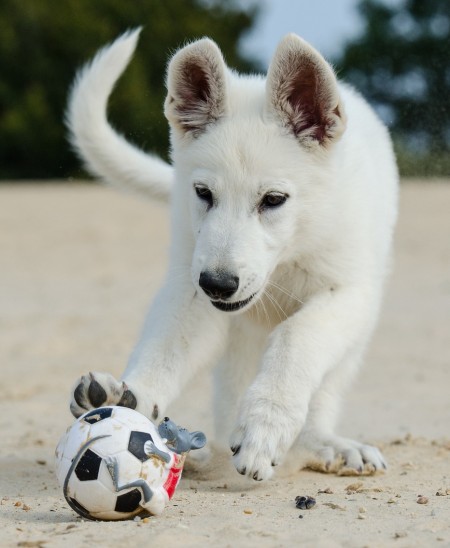
The bad news is that most breeds are NOT natural retrievers.
Here's an example of how difficult retrieving is for so many dogs. In obedience competition, many dogs succeed at the novice level. But far fewer succeed at the intermediate and advanced levels. Why? Because at the higher levels, dogs must retrieve. That single requirement knocks out a whole lotta dogs!
So if you have a dog who won't retrieve, don't feel alone. You can try to teach him, but don't be disappointed if it doesn't go as smoothly as you would like.
Retrieving down a hallway
Do you have a long narrow hallway in your house? Close all the doors along it so that as your dog runs down the hallway, he can't duck into any side rooms. If a room doesn't have a door, block it off with boxes or some other barrier.
Get your dog excited about his favorite ball or toy, then toss it down the hall. Encourage him, "Fetch!" or "Get it!"
If your dog runs after his thrown toy, if he picks it up, and – miracle of miracles – if he brings it back to you, tell him happily, "Good! Give." Then immediately throw it again. You want him to learn that bringing a thrown object back to you causes it to immediately fly again. (Of course, you will need to stop some time!)
There.... wasn't that easy?
Probably not! There are a number of things that can go wrong...
Fetch problem #1
Suppose your dog brings the toy back to you, but dances out of reach or refuses to give it up. If this is your pup, don't play fetch without first attaching his leash. Then if he tries to play keep-away, you can step on the dragging end of the leash as you continue to encourage him to come all the way to you.
Fetch problem #2
It's very common for a dog to chase the ball and pick it up.... but then just stand there looking at you without bringing it back.
Crouch down to make yourself more interesting and inviting. Pat your hands together or pat your hands against your thighs in an encouraging manner.
If he takes a step or two toward you, praise him. "Gooood! Bring it here!" You want him to connect praise and "Bring it here" with the action of heading toward you with something in his mouth.
Don't expect perfection. It's okay if he brings it a little way, then drops it. Just walk over and get it. Then toss it again. Hopefully he will improve with experience, especially if you actively look for opportunities to encourage your dog to "Bring it here" when he happens to be standing anywhere with a toy in his mouth.
Fetch problem #3
Suppose your dog doesn't show any interest in chasing the ball. Or perhaps he chases it but won't pick it up. Okay. Try the next game, which is....
Retrieving into a corner
Take your dog into a room with an accessible corner where you can kneel a few feet away from the corner, but facing into the corner.
You're going to toss the ball or toy gently into the corner so that it bounces back off one of the walls.
Some dogs who won't chase a ball down a long straight hallway become more enthusiastic when the ball is tossed only a few feet and unexpectedly bounces back. You're trying to stimulate any chasing instincts your dog might have.
Some dogs will begin by chasing the ball but not picking it up. Only later will they begin picking it up, and still later they might begin moving in your direction to return it to you. It's a process, so be patient and encouraging.
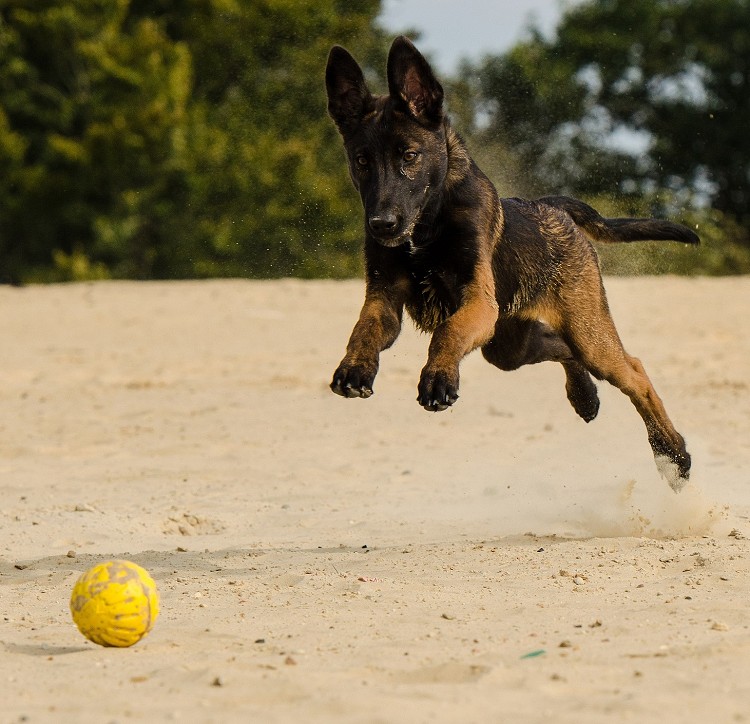
Retrieving outdoors
Occasionally a dog who won't retrieve indoors will be more enthusiastic outdoors, so give that a try.
If your pup has learned to Come when called 100% of the time, you shouldn't need a leash. If he hasn't learned Come, he should have a leash or cord attached to his (buckle) collar and dragging.
How long should the leash be? With a dog who stays pretty close to you, or if your yard is very small, a 6-foot leash is fine. With more adventurous pups who might grab the ball and take off, especially in a large yard, a 15- or 20-foot leash is easier for you to step on and stop his flight. Then you can gently reel him in to continue the game.
Retrieving on command
If you're hoping to compete with your dog in a sport that requires retrieving, or if you simply want a dog who will retrieve reliably, the game needs to become a command. There are several good systematic methods for teaching a reliable retrieve, but that's beyond the scope of this article.
Teach your dog to play a (controlled) game of Tug
In Tug-of-War, you hold onto one end of a toy while your dog holds onto the other end and tries to pull it away from you.
Tug is a controversial game.

Many breeds, like this Rottweiler pup, are very enthusiastic about playing Tug. But to avoid behavior problems, be sure to play it properly.
On the plus side....
- Tug is a convenient way to provide an active dog with a quick physical workout. Exercise keeps your dog's body trim and fit and gives him an outlet for relieving stress and tension.
- Tug gives your dog the opportunity to use his natural instincts to mouth and chew and bite, without hurting anyone or destroying things. He can bite down on the Tug toy with all his strength and not get corrected for it.
- Tug is an interactive game – you and your dog play together in a give-and-take manner.
On the other hand, Tug does encourage a dog to clamp down with his teeth, growl, resist and fight against you. Not really what you want a family dog to do, right?
Now, I've been playing Tug with my own dogs for decades. When played properly, Tug can be a satisfying, one-on-one bonding time between leader and follower. But I'm cautious about recommending the game to other owners because they might play it improperly.
So it's up to you whether you want to try this activity or not. If you're wavering, I recommend first being sure you understand how to teach and play the game properly. Then be able to execute your game plan. If you both have a good time and you see no negative effects going forward, great!
How old should your dog be to play Tug?
You can play tug with puppies at 2 to 4 months old (before they begin teething) and after 6 or 7 months old (when they're done teething).
During the teething period of about 4 to 6 months old, a puppy's gums and emerging teeth are too tender for tug games. Put away Tug toys and wait a few months before bringing them out again.
Caution: tug toys are NOT chew toys. They should never be left for the pup to chew on. Tug toys should be kept apart from other toys and only brought out for interactive play with YOU.
What are good Tug toys?
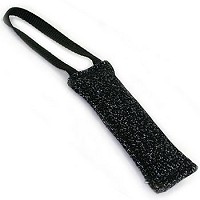
Synthetic fabric puppy tug by Leerburg Online
With smaller pups, you can play Tug with a soft braided rope, a hand towel tied to a short rope (you hold onto the rope as a handle), or a knotted pair of socks.
For larger dogs, you might want a more durable commercial toy. Leerburg Online sells great Tug toys such as this lightweight puppy tug.
I repeat: tug toys are NOT chew toys. They should never be left down for the pup to chew on. Tug toys are for interactive play with YOU. After the play session, put the tug toy up on a shelf.
Where to play Tug
Tug is an energetic game, so it really should be played outdoors. Remember, you want your pup to be calm indoors.
But if you have a basement or game room, you might decide to designate that space for active games such as Tug or Fetch. If you're consistent, your dog will learn that this is the fun room, but that he needs to be calm in the rest of the house.

Your pup's first Tug game
If you're in a smallish area, your pup doesn't need a leash. But if the area is larger and your pup is the kind of explorer who will likely run away from you, a long leash should be attached and dragging so you can control his behavior as needed.
Don't give him the chance to run off with the Tug toy. You want him to learn good habits, not bad ones.
When you bring out the Tug toy, show it to your dog and name it: "Tug. Tug Tug. Play Tug?" Keep your voice upbeat and encouraging. Appeal to your dog's prey instinct by twitching the Tug along the ground like an agile, quick-moving prey animal like a chipmunk.
First the Tug is still. Then it does a quick, wiggly movement. Then it freezes again. Then suddenly leaps to one side. Make it interesting!
If your dog grabs hold of the Tug, keep moving it like the prey animal is trying to get away – but not too forcefully! If you rip it away from your dog, he will either become discouraged or he will frantically try to re-grab it and end up accidentally closing his teeth on your hand. Obviously another bad habit not to start.
It takes some practice to learn just how much you should move the Tug to keep your particular pup interested. Every dog is different. Some are persistent and focused, while others are more casual or easily distracted.
Once he is firmly gripping the Tug toy, many dogs don't mind their front feet being lifted off the ground – AFTER they're done teething. But don't lift your dog completely off the ground! You could damage his joints, tendons, ligaments, backbone, or spinal cord.
Similarly, don't whip him vigorously back and forth, else you will damage his neck vertebrae or teeth.
This is a GAME. Keep it playful and encouraging, not competitive or violent.
Let your dog win!
Who should win games of Tug? Traditionally it was thought that you, as the leader, should win. But with this particular game, it's more satisfying if you BOTH win.
Let me explain...
After 5 to 10 seconds of Tugging, step on the end of the leash, let go of the toy, and let your dog parade around you in triumph, carrying his prize.

Once he's made a couple of proud circuits around you, use the leash to guide him closer so you can stroke him approvingly along his sides and back while he holds the toy. You want him to feel proud of himself, to think: "Look at me! Aren't I something?" And you want him to connect these great experiences with YOU, his beloved leader.
And yet your dog must learn to let go of the toy.
The one essential rule of Tug games
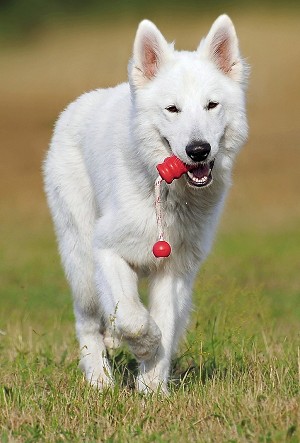
Your pup shouldn't be allowed to play with tug toys by himself. These toys should be reserved for interactive play with YOU.
Although you've let your pup "win" the round so far, there is an essential rule that you must teach him.
He must release the toy when told to.
After the dog has had a minute to parade around with his prize, it's time for you to get the toy back. He must release it so YOU can decide whether to start another round or end the game.
Your pup needs to learn that the only way to play with this particular toy is with YOU. So whenever he "wins" by pulling the Tug toy away from you, the game can only continue if he brings the toy back to you and releases it.
Teaching your pup to give up the Tug toy
Get hold of his dragging leash and bring him close to you. Take hold of the toy and say "Give" or "Drop" or whatever your let-go word is.
Now, understandably your puppy might be reluctant to part with such a wonderful toy. He might even think that since you've put your hand back on the toy, you're starting up the game again. This is natural for a beginner dog to think, so if he starts to tug at the toy again, don't get mad! You don't want to dim his enthusiasm.
Just stand very still and hold your end of the toy very still. Say again, "Give" in a calm voice. Your stillness makes the game much less fun for your pup – he sees that you're refusing to play, so he's more likely to let go.
But if he absolutely won't let go even when you're holding the toy very still, open his mouth so that he must release the toy. In the article on teaching your pup to release or drop an object, you learned two ways to open your pup's mouth.
When you finally have the toy, praise him cheerfully ("Good dog!") and immediately continue the game. Say, "Tug! Play Tug!" and start moving the Tug in that enticing prey animal pattern.

Cairn Terrier waiting eagerly for you to begin the next round of Tug
You want him to learn that giving up the toy doesn't mean the game is over. In fact, giving up the toy is the only way to get you playing again!
In this way, he learns that YOU are a vital part of this game. He can't play it by himself.
Of course, eventually you will need to decide that the game is over. When he releases the toy and you're not going to continue, give him a few tasty treats so as to end things on a happy note.
What to do about growling during Tug games
First, YOU shouldn't growl during Tug games! Yes, some owners do make their own growling or rrr-rrr-rrr sounds when they play Tug.
For some dogs, this is fine, but it's safer if you keep your own sound effects to a minimum. Having their leader growl at them can over-stimulate some pups and intimidate others.
As for your dog's own growling sounds, some pups are just naturally more vocal than others...
However... growling can also be a sign of anxiety. When a dog becomes anxious, he might growl in a blustery attempt to convince you that he's one tough dude who should not be messed with!
You can relieve his anxiety by lowering the intensity of the game. Pull less forcefully. If he stops vocalizing, you can try slowly building back up again to find out what level works best for him.
Now, if he's growling while refusing to give up the toy, that's a different kettle of fish. Deliver a sharp "AH-ah" and end that play session.
Similarly, you should stop the game if your dog:
- just gets too crazy
- jumps all over you
- repeatedly grabs at your hand instead of the toy
You might try again on a different day, or you might wait until he's more mature and more settled in his follower status. Or it might turn out that Tug is simply not a good game for this particular pup.
Young children should NOT be allowed to play tug of war with a dog. Young children can't judge when a dog is out of control and they can't correct a dog with enough authority when his behavior goes over the line. This ends up teaching and reinforcing bad habits instead of good.
What if your dog won't play tug?
Not all dogs enjoy playing Tug. Some have very little prey instinct. Some are so gentle and submissive that they're intimidated by the idea of grabbing hold of a toy in your hand and trying to wrest it away from you.
But before you give up, try making the game less intimidating – move the toy farther away from your own hand.
For example, tie the Tug toy onto one end of a 2- or 3-foot cord. Hold the other end of the cord and manipulate it so that the Tug toy bounces around in a (hopefully) enticing way. Your pup might just pounce on it and then the pair of you can play Tug separated by a few feet. Over time, you can gradually work your hands along the cord, closer and closer to the toy.
Teach your dog to negotiate an obstacle course
 In the sport of dog agility, which you may have seen on TV or on YouTube, dogs run through an obstacle course – jumping hurdles, dashing through tunnels, and traversing balance beams.
In the sport of dog agility, which you may have seen on TV or on YouTube, dogs run through an obstacle course – jumping hurdles, dashing through tunnels, and traversing balance beams.
Dog agility is not only great fun, but also provides a constructive physical outlet for your pup's energy. Mastering agility obstacles improves his coordination and self-confidence, as well.
You can play such a game in your own backyard (on GRASS or DIRT, not on concrete), or even in a large indoor game room (on CARPET, not wood, vinyl, or tile).
You can buy obstacles online from affordableagility.com (still expensive, just less so than most other agility sources). Or if you're handy, you can make a few simple obstacles yourself. Just make sure they're very sturdy!
If you assure your pup that something is safe, and he falls off it, or it collapses, he will lose faith in you and may never want to try anything new again. So build sturdy or else buy commercial!
"Jump" or "Over!"
 A jump can be a solid hurdle or a bar jump (two vertical posts supporting a horizontal bar). You can construct a bar jump using plastic PVC pipe, which is lightweight and inexpensive.
A jump can be a solid hurdle or a bar jump (two vertical posts supporting a horizontal bar). You can construct a bar jump using plastic PVC pipe, which is lightweight and inexpensive.
To make it easier for your pup to see, wrap strips of colored contact paper around the white pipe at spaced intervals. Or use paint.
Very important: keep jumps set low!
Don't set the height of a jump based on how high your dog can jump – but rather on how LOW it should be for safety.

The legs of puppies and adolescent dogs have growth plates that expand as the pup grows. While those growth plates are still expanding, a pup's bones and joints are very fragile. Jumping too high or too often can severely damage them, sometimes irreparably.
It's the impact of landing that causes the most stress on bones and joints.
When do the growth plates close permanently? If your pup will mature at less than 50 pounds, his growth plates should close at 10 to 12 months old. If he will mature at over 50 pounds, his growth plates typically close at 12 to 14 months old.
Until their growth plates have closed, a pup should only jump his height at the elbow, or 12 inches – whichever number is LESS. The elbow is the bony protuberance on the backside of his front leg, just below where the leg attaches to the body.
Once his growth plates have closed, jump height can be increased to the top of his shoulder blades. No dog should be jumping higher than their shoulder blades on a regular basis. It's simply unnecessary, especially from a health and safety perspective.
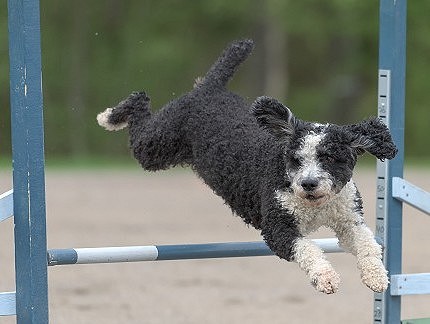
Spanish Water Dog clearing a bar jump.
Secure footing on both sides of the jump is essential. Dogs are injured during take-offs and landings when they slip on a slick surface or come down hard on a surface that's rigid and unforgiving.
So.... yes to dirt, soft grass, rubber matting, and carpeting. No to bare wood, vinyl, tile, concrete, stone, and sharp prickly grass.
To teach your dog to jump:
- Place two or three jumps about ten feet apart. Set each jump no more than the height of the dog's elbow, or 12 inches – whichever number is LESS.
- With your dog on leash, walk over the series of jumps with him. As you reach each jump, say, "Jump!" or "Over!"
- Reward with a treat when you've cleared the last jump. Soon you can increase your speed to a trot. Finally, trot toward the jump with him, but at the last second, you should veer around the side of the jump while he goes over himself.
A mistake made by impatient owners is to take their dog off-leash too soon! An off-leash dog can easily veer around the jump and once this bad habit has been introduced to his brain, it can be difficult to cure. So be patient. Keep your dog on-leash until his brain has formed the rock-solid pattern that "Jump" always means OVER – never around.
"Go Tunnel!"
 You can buy a children's play tunnel made of vinyl (kind of flimsy) or nylon (better quality) from a local toy store or from Amazon. Or you can buy a more durable tunnel from affordableagility.com
You can buy a children's play tunnel made of vinyl (kind of flimsy) or nylon (better quality) from a local toy store or from Amazon. Or you can buy a more durable tunnel from affordableagility.com
You can also make a short homemade tunnel out of large boxes, or a trash can with the bottom cut out. At first, use a short straight tunnel so the dog can see through to the other side.
Brace the tunnel securely along both sides so it can't roll while your pup is inside, which could spook him.

Pyrenean Shepherd racing through the tunnel. See the heavy sandbag weights securing the tunnel so it can't roll. Most dogs come to LOVE tunnels!
To teach your dog to go through tunnels:
- Have a helper hold your dog by the collar at one end of the tunnel while you crouch at the opposite end.
- Stick your head inside and call, "Jake, here I am, Jake!" Wave a treat inside the tunnel to get his attention. You want him to peer in and make eye contact with you so you can encourage him to come through.
- Once he's all the way into the tunnel, your helper should make sure the dog doesn't suddenly change his mind and try to back out the same way he went in. This is common for beginner dogs who lose their nerve halfway through!
So once he's in, whatever you have to do, try hard to make sure he comes out the other side. When he reaches you, he gets praise and a treat!
When your dog is confident about a straight tunnel, curve it into a "U" shape. This can be psychologically difficult for some dogs because they can't see any light at the other end. They have to enter the dark end and trust that there will be an exit.
Finally, if the tunnel is long enough, you can curve it into an "S" shape.
"Go Table!"
![]() The Pause Table is a 3-foot by 3-foot platform set on four sturdy legs 8 to 24 inches high, depending on your dog's size. Make sure the table is covered with securely-fastened, non-slip carpeting or rubber matting.
The Pause Table is a 3-foot by 3-foot platform set on four sturdy legs 8 to 24 inches high, depending on your dog's size. Make sure the table is covered with securely-fastened, non-slip carpeting or rubber matting.
You tell your dog "Go table!" and he must jump onto it and remain there for 5 seconds, then you send him on to the next obstacle.
The Pause Table is extremely easy to teach if your dog already knows "Go to your bed" or "Go place".
To teach your dog the Pause Table:
- Pat the table with your hand, tell your dog in a cheerful voice, "Go TABLE" and hold a treat above it. When your dog jumps onto the table, place the treat ON the table so he can eat it. Caution him, "Wait" (taught in my book) while you count silently to five. Then release him with "Okay!" and encourage him to jump off the table.
- Next step is to place a treat ON the table so he can see it. Take him by the collar and lead him about six feet away. Turn him toward the table and encourage him, "Go table!" Release his collar and run to the table with him.
- Next, hang further back so he is running to the table without your needing to run beside him. Gradually extend your distance until you can send him to the table from a good 20 feet away!
- Finally, instead of placing a treat on the table beforehand, keep it in your pocket and simply send your dog to the table.
Never reward your dog for jumping OFF the table. If he jumps off before you reach him, say "Ah-Ah. Go table!" Only give him his treat ON the table, so he learns to get up there and stay put.
"Walk it!" (balance beam)
![]() In agility competition, it's called a dogwalk. It's a wide balance beam with a ramp at each end. The dog trots up one ramp, trots along the central plank, and trots down the far ramp.
In agility competition, it's called a dogwalk. It's a wide balance beam with a ramp at each end. The dog trots up one ramp, trots along the central plank, and trots down the far ramp.

You can make a partial dogwalk with just the central plank (no ramps) by taking a board (at least a foot wide, and 4-8 feet long) and raising it off the ground a few inches with concrete blocks.
You can also add ramps, as long as they're not too steep and as long as you prop them securely (or better yet, attach them to the central plank) so they can't fall. If a ramp suddenly plunks to the ground while your pup is walking on it, it might be too low to hurt him physically.... but psychologically, it could be very bad and he might never walk on it again.
Remember.... safety, safety, safety. Build obstacles sturdy. Keep obstacles low. Keep your pup's leash on when he's learning. Accidents and fearful experiences can have long-lasting consequences.
Use treats to lure your pup across the dogwalk, going nice and slow. Some dogs are more adventurous, while others are more cautious. In general, small and medium-size breeds have better coordination than larger breeds.
 See the yellow painted area? That's called a contact zone and your dog is supposed to touch it on the UP incline AND on the DOWN incline as well. This is to prevent him from the dangerous habit of taking those ramps too fast and even jumping off them.
See the yellow painted area? That's called a contact zone and your dog is supposed to touch it on the UP incline AND on the DOWN incline as well. This is to prevent him from the dangerous habit of taking those ramps too fast and even jumping off them.
Hence the yellow paint, as a reminder to TEACH your pup that for his own safety, he must touch the bottom of the ramps.
Building confidence with different surfaces
It can be amusing to watch a dog's reactions when he encounters a type of footing that he has never traversed before. Some pups aren't fazed by anything, whereas others totally balk.
Just as it's good for us to learn new skills and try new things, it's good for dogs, too. The more things you expose them to, the more comfortable they are in the world that we all share.
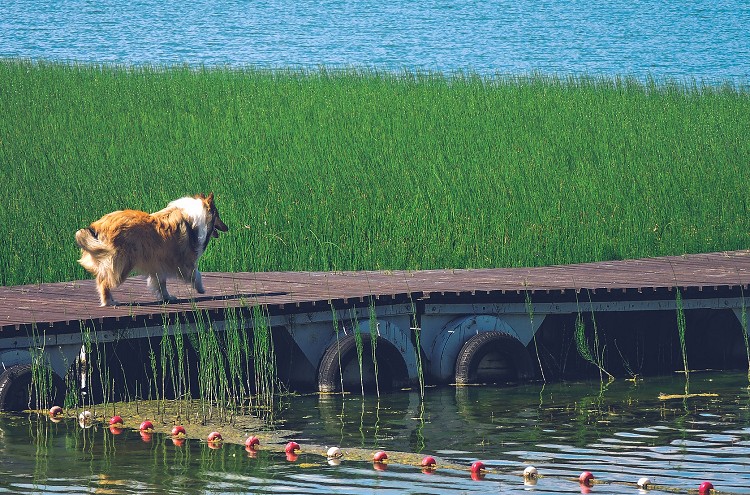
So think of things that your dog hasn't encountered yet. For example, different types of surfaces that he might one day need to walk across.
You might lay down:
- plastic sheeting or a crinkly tarp
- ceramic tiles
- soft sand
- a metallic surface of some kind
- a layer of crinkly leaves
- a shallow pool of water
- low platforms for your pup to hop on and off
As you walk him around your obstacle course, on leash at first, coax him over the different surfaces. Remember, this is a GAME. Use treats liberally, and no corrections!
Games NOT to play with your pup
I don't recommend wrestling games.
- If you use your hands to playfully wrestle with your pup, you're encouraging him to mouth and nip at your hands.
- Wrestling games also teach him to resist and struggle when you try to roll him onto his side or back. Those positions are important for grooming and health care. You don't want him resisting those positions.
I don't recommend chasing games.
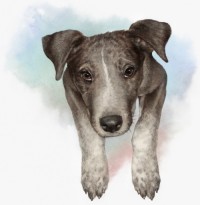 It can seem like great fun to creep toward your puppy with your hands outstretched like claws, whispering in an ominous tone, "I'm... gonna.... GET YOU!"
It can seem like great fun to creep toward your puppy with your hands outstretched like claws, whispering in an ominous tone, "I'm... gonna.... GET YOU!"
Or when you stamp your foot and make a teasing lunge toward him, and he woofs in alarm and dashes away. Upload it to YouTube and watch the Likes pour in!
Unfortunately, chasing games are not good for your relationship with your puppy. What you're doing is teaching him that when you reach for him, he should run away from you. In fact, he can quite easily evade you, which you definitely don't want him to learn.
![]() What if your PUP is the one doing the chasing? Should you encourage your puppy to chase after YOU?
What if your PUP is the one doing the chasing? Should you encourage your puppy to chase after YOU?
Well, that depends....
- If he is otherwise well-behaved, and he just lopes playfully after you without nipping or jumping, and if when you stop running, he settles down quickly... fine.
- But if he gets so excited that he nips or jumps, or shoves his body against your legs, or tangles up your feet, you don't want to encourage that kind of behavior.
Some pups simply can't engage in chase games in a civilized manner. Often these pups have a strong prey instinct compelling them to grab things that move.
Young children should not play chase games with a dog. Young children can't judge when a dog's behavior is over the line, and they can't correct a dog with enough authority. For safety's sake, don't allow your dog to chase any child, and don't allow your kids to run away from your dog.
My best-selling books – now available FREE on my website
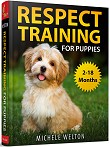 Respect Training For Puppies: 30 seconds to a calm, polite, well-behaved puppy is for puppies 2 to 18 months old. Your puppy will learn the 21 skills that all family dogs need to know. Click here to read for free.
Respect Training For Puppies: 30 seconds to a calm, polite, well-behaved puppy is for puppies 2 to 18 months old. Your puppy will learn the 21 skills that all family dogs need to know. Click here to read for free.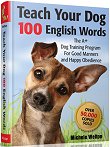 Teach Your Dog 100 English Words is a unique Vocabulary and Respect Training Program that will teach your adult dog to listen to you and do what you say. Click here to read for free.
Teach Your Dog 100 English Words is a unique Vocabulary and Respect Training Program that will teach your adult dog to listen to you and do what you say. Click here to read for free.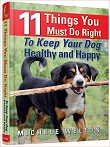 11 Things You Must Do Right To Keep Your Dog Healthy and Happy helps your dog live a longer, healthier life. Get my honest advice about all 11 Things before you bring home your new puppy, because some mistakes with early health care cannot be undone. Click here to read for free.
11 Things You Must Do Right To Keep Your Dog Healthy and Happy helps your dog live a longer, healthier life. Get my honest advice about all 11 Things before you bring home your new puppy, because some mistakes with early health care cannot be undone. Click here to read for free.
